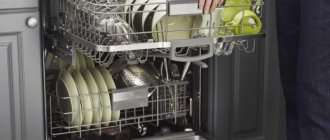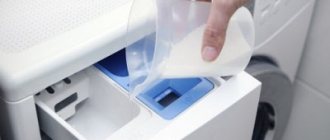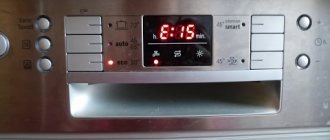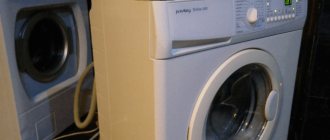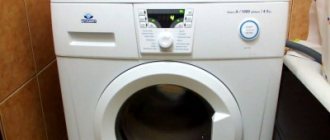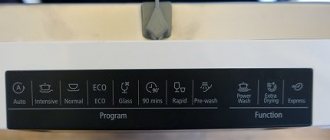Each of us is familiar with the feeling of impatience when we want to quickly try out a new household appliance that we just purchased in the store. But there are times when there is no need to rush, for example, the first start-up of a Bosch, Samsung or any other brand dishwasher should be carried out according to the instructions.
The equipment of different manufacturers differs significantly, so strict adherence to the instructions contained in the manual is mandatory during the first use . You will find general information and useful tips in our article.
Do not rush to put dishes in a new dishwasher - you do not need to do this during the first start
How to load dishes into the dishwasher?
When starting to use a dishwasher, first learn how to load dishes into it correctly. If you ignore the recommendations, you can get back not only dirty plates, but also break your equipment.
Typically, a dishwasher has two baskets and a compartment for cutlery. The upper basket is designed for plates, cups and other small dishes. And the lower one is for pots, pans and larger items.
If the machine has the ability to adjust the height of the basket, adjust it so that the water is distributed evenly.
Tips for loading dishes into the dishwasher:
- When using a built-in dishwasher, before loading, remove any remaining food from the dishes - bones, large pieces, etc. Otherwise, there is a risk that the filter will become clogged.
- For the sake of economy and absolute cleanliness, if the dishes are very dirty, first rinse them in the sink. You will remove heavy dirt, thereby making the machine easier to operate and increasing its efficiency. This advice is especially needed for those users who do not have a soaking program.
- Fill the lower basket first, and then the upper one, but do not confuse their purpose. We talked about this above.
- It is better to place plates, etc. with the inside facing the center. Place large dishes on the edge. Keep a distance between dishes in the holders, otherwise they will not be washed well.
- Cups, etc. Place them upside down to prevent liquid from flowing into them. If you wash glasses and other fragile glass, do not place other dishes close to them.
- Place cutlery separately in the drawer with the handles facing up so that water can run down them.
- Use the dishwasher correctly, loading very dirty dishes in one cycle, and cleaner ones in another. Place baking sheets on their sides, and pans with the bottom facing up.
- Don't make the dishwasher difficult to close. There should be free space between the dishes so that each appliance has enough water and you get cleanly washed dishes.
What can't be washed in the dishwasher?
Tree
If a tree is placed in water for a long time, it will expectedly swell and increase in size. Those. wooden spoons, rolling pins, etc. utensils will become unusable.
After drying, the bond between the fibers will be destroyed, and such dishes will still remain with defects: a different shape, cracks, roughness.
Even if you are not going to put wooden dishes in the dishwasher for a long time, the effect will be the same due to boiling water and detergents.
Plastic
You can use the dishwasher and load plastic dishes, as long as they are heat-resistant. Look for the icon that allows the machine to wash.
We do not recommend loading into the lower basket, because... the heating element is closest to it, the products may melt. You cannot wash disposable tableware!
If you have dishes that can maintain a vacuum inside, then they also cannot be washed in a machine. Otherwise, the plastic will deform and the container will lose its seal; in other words, air will begin to enter it.
Porcelain
It is better to take care of beautiful porcelain sets with your hands. Hot water may cause small cracks to appear on the porcelain, ruining its appearance.
Also, the painting may not be as bright if it is not covered with varnish. If you are at risk, then choose the “Delicate Wash” program.
Crystal
If possible, take care of the crystal yourself. He is afraid of the high temperature changes that exist in the dishwasher. Or turn on the “Delicate Wash” program.
Metal
When using a dishwasher, you need to know something about metal. It is better to wash silver in the sink, because... from contact with other metals (for example, stainless steel), the products will turn black.
Bronze, tin, and brass objects also lose their color, which is not easy to restore later.
Aluminum, despite the protective film, can become dark gray from boiling water and chemicals. And cast iron will not suffer from corrosion after regular washing.
Other
When deciding to use the dishwasher correctly, do not use it to wash:
- Sharp knives, they will become dull.
- Unglazed clay dishes, otherwise particles will clog the filter.
- Thermos, etc., if it does not have a dishwasher safe symbol.
What means should I use?
For proper operation of the dishwasher you need to use detergents, let's talk about them.
Salt
Salt is used to soften water because... It is not recommended to wash dishes in our hard water. Firstly, it reduces the effectiveness of the funds. Secondly, scale appears on the products, and the machine itself may eventually fail for this reason.
How to use dishwasher salt? Before the cycle begins, salt is poured into a tank at the bottom of the chamber. At the end, a saline solution is sprayed into the container, leaving it for 15 minutes.
For about 20 sessions you will need 1.5 kg of salt, the consumption depends on the hardness of the water. It is easier to find out the hardness using test strips. And based on this, set the parameters on the regulator responsible for how much salt the exchanger will take.
If you run out of salt, you will see a notification on the panel.
As soon as you start using a dishwasher, you will realize that there are a lot of cleaners and detergents. Moreover, they are presented in different forms: powders, tablets, gels.
The main rule is to use dishwasher-safe products only. Do not replace them with soap, washing powder, or anything else. Otherwise, at best, the equipment will have to be sent for repair.
Today, dishwasher tablets and powders are especially popular. Users like the tablets because they don’t need to calculate the quantity; some even have a break strip (if the machine is half loaded).
But the disadvantages are that in small cycles the tablet does not completely dissolve. And this product costs more than the powder.
Most often, users around the world use finish products for the dishwasher. This manufacturer produces everything: powders, tablets, gels.
Benefits of Finish detergents:
- A manufacturer with a rich history (more than 20 years) and good reviews, one of the first to produce tablets for dishwashers.
- There are no strong chemicals in the composition.
- Natural ingredients and oxygen do not form foam during washing and do not harm equipment.
- All products have been tested and are safe.
- A large assortment of powders, gels and various tablets, which allows you to choose the best product for yourself, including cost.
- Finish tablets for the dishwasher contain substances that, when used, not only effectively wash, but also soften water.
How to use finish for dishwashers?
Rules:
- Fill the machine with dishes.
- Place the tablet.
- Select a temperature of 50-55 degrees.
- Launch it.
Rinse aid
Thanks to the rinse aid, there are no water stains left on the dishes. It looks like a liquid detergent that is poured into the compartment on the door when using the dishwasher.
Washing and drying modes
PMM models may differ in the set of programs for washing dishes and drying. The quantity largely determines the power of a household appliance and its cost. There are a number of modes, including:
- auto;
- standard;
- fast;
- delicate (for example, in a Bosch SPV4030RU machine);
- economical (such a program is present in SMV30D20RU models);
- intensive (specified in the operating instructions 40E10RU 2 series);
- with additional rinsing.
The washing programs performed by Bosch dishwashers are divided into:
- automatic;
- fast;
- delicate;
- economical;
- normal;
- intense;
- with pre-rinse.
The programs are developed taking into account the type of dishes, the materials from which they are made, as well as the type and intensity of dirt present on them.
Each of the available programs takes into account the following factors regarding the washing procedure:
- water temperature;
- duration of the process;
- volume of water consumption;
- type of detergent used;
- mechanical impact method.
When performing standard programs, the wash duration and water temperature are preset parameters. Each type of dishware has its own program, taking into account the degree of soiling.
Standard modes include delicate, eco and intensive wash. Various temperature ranges are provided to implement automatic programs. The machine determines water consumption, duration of operation and washing temperature within the prescribed range independently, based on the readings of aquasensors.
For example, reacting to the degree of soiling of the dishes, the machine can increase or decrease the number of rinses.
There is a separate program for different types of dishes and types of soiling; all that remains is to choose from the variety of washing modes that will help the housewife find the optimal solution for her tasks.
Programs, which include, for example, soaking, effectively complement the basic washing algorithms. This is the implementation of additional capabilities of Bosch technology. For example, if dishes have just been used, they can be washed in accelerated mode with a shortened wash cycle occurring in just 29 minutes.
The Turbo speed-20min program can be called an innovation. Its use allows you to wash dishes even in 20 minutes. Such a program will help out the hostess if she has to set the table with the same items several times over a short period of time.
There are also additional options that significantly make the owner’s life easier and help her out in extreme situations.
Additional programs expand the capabilities of standard functions:
- Timer. Using the timer, the start of washing can be delayed for any time period ranging from one to 24 hours.
- Hygiene. If additional hygienic treatment of dishes is necessary, it can be done by lengthening the last phase of the cycle and increasing the temperature at which it passes.
- Vario Speed. You can speed up the program without losing the quality of the final result by forcing both liquid spray arms to work simultaneously. This option is available in the Vario Speed Plus variation on premium units. At the same time, operating time is reduced by 66%.
- Half load. If the chamber is only half loaded, this nuance should be taken into account, accordingly reducing the consumption of water and detergents.
- Intensive zone. This option allows you to wash dishes in the lower basket more intensively. In other levels the program will run in the main mode. Using this option, you can process dirty pans and fragile wine glasses at the same time.
- Shine & Dry. New option available for wine glasses and glassware. Thanks to additional rinsing, increasing the volume of rinse aid and long drying time, the glass acquires an incredible shine.
We suggest you familiarize yourself with How to remove limescale in a bathtub, effective methods
If the instructions for your model provide such an option, then at the first stage of the machine’s operation you can add a forgotten item to it, temporarily interrupting the wash. To put the machine into standby mode, carefully open the door. After closing it, the program running by the machine will automatically continue.
A very convenient additional function is provided by a timer, which helps to delay the completion of work for a given period of time, which allows the housewife to manage her time more successfully.
Completion of work will be indicated by a sound and light (beam on the floor) signal. It is customary to unload the boxes starting from the lower basket. At the same time, drops that may remain on the upper baskets will not spoil the appearance of the items located below.
If you adhere to the requirements stated by the manufacturer, your unit will serve you for a long time.
Starting the dishwasher for the first time
When you use a dishwasher for the first time, you need to understand its structure well:
- The chamber door can stand in the block while the machine is operating so that it does not accidentally open.
- Baskets, holders, shelves are needed for dishes.
- Sprayers can be either at the bottom or at the top of the machine. They spray water, washing away dirt from objects.
- The control panel can be mechanical or electronic (touch). If you use a built-in dishwasher, you will see the panel on the outside of the door.
- The salt compartment is located next to the drain - at the bottom of the pan. Reservoirs for detergents are on the door.
To start a test wash:
- Open the door.
- Remove the lower basket.
- Open the salt compartment and fill it with water, then add salt.
- Set to medium cycle and high temperature.
- Run the dishwasher without dishes.
These instructions are suitable if this is your first time using a Bosh dishwasher or any other manufacturer.
Specifications
The equipment is equipped with a metal case with a hinged front door. On the upper front edge of the 45 Edition Series doors there is a control panel with display. Modifications with a width of 600 mm are equipped with a door that allows for the installation of a facade slab (made of wood or chipboard). The control panel is located at the end of the sash, the springs are equipped with stiffness regulators that compensate for the additional weight of the lining.
Inside the washing chamber there are pull-out trays for dishes, equipped with height adjustment and folding elements. To supply water, rotating nozzle blocks are provided; sprayers are provided at the bottom with the ability to supply water under increased pressure. Inverter-type motors are mounted to drive the pump and injector units, which increase the reliability of the machine while simultaneously reducing power consumption.
Water consumption depends on the capacity of the washing chamber and the power of the installed heating element.
Machines with a body 450 mm wide consume up to 10 liters of water per cycle, products with increased capacity consume up to 13 liters of liquid.
How to choose a program for your dishwasher?
Before starting the machine, check again that the dishes are positioned correctly, see if there are any unnecessary items, and if all the detergents are filled. And then you need to select a program.
Their set differs depending on the brand and model of the dishwasher. Let's talk about the main programs that are most often used in dishwashers.
Soak
This mode is needed for cleaning very dirty items, when there is grease, pieces of dried food, etc. First, the dishwasher will soak to make it easier to work with, and then it will remove the remaining dirt even without a product.
Intensive wash
Set this program for very dirty dishes; it consists of two stages - preliminary and main. The temperature can be up to 80 degrees and the machine consumes a lot of water and energy, so you should not choose intensive washing unless absolutely necessary.
Normal mode
The machine can handle medium-sized stains, for example, if you just used a pan and decided to wash it. The temperature is up to 65 degrees, and the washing time is about 1 hour.
Economical
Due to the low temperature - up to 55 degrees, energy consumption is less. Also, if you choose a half load, you can reduce the consumption of not only energy, but also water.
Fast
Suitable for not very dirty dishes, temperature up to 55 degrees, but cycle time is shorter.
Delicate
Select this program when using the dishwasher for anything fragile: crystal, porcelain, glass, etc. Temperatures up to 45 degrees. But cold water won’t help with heavy dirt, so you’ll have to wash something by hand.
Installation and connection
PMM is a complex household appliance. To ensure its proper functioning, installation must be carried out according to the manufacturer's recommendations.
- The device must be checked before purchasing. This will help avoid possible problems in the future.
- All additional parts included in the package are installed.
- Leveling the machine using a building level. Otherwise, the device may not wash and dry dishes well and make strange sounds.
- Connecting the dishwasher to the drain. If necessary, a siphon can be attached. The sealing of seams should be carefully checked.
- Connection to water supply. The hose only needs to be connected to the cold water system. In this case, flexible parts should not be twisted or pinched.
- Network connection. The socket must meet the requirements of the household appliance. It is best to install the power source in close proximity to the machine.
Most models, regardless of the series (Bosch S2R1B, Bosch SMV3020RU), have similar installation requirements, but it is better to check the instructions.
How to use different brands of dishwasher?
Instructions for Bosch
After the Bosch dishwasher is installed and connected, the rules of use will be as follows:
- In the settings program, select the product you are using - powder, gel, tablets. And load it into the container on the door. And check the presence of rinse aid and salt using the indicators on the panel (if any of them are on, you need to replenish supplies).
- Next, load the dishes.
- Close the door.
- Select a program.
- Turn on additional functions - partial loading, delay timer, etc.
- Start the washer.
How to use a Siemens dishwasher correctly?
Using a Siemens dishwasher correctly is also not difficult:
- Press the power button or turn the lever;
- Load up all the products, including salt if you have run out and rinse aid.
- Load items.
- Close the door.
- Select a mode.
- And start the machine. After the cycle ends, you will hear a melody and the indicator will light up, which means you can open the door and take out clean dishes.
How to use an Electrolux dishwasher?
The rules for using an Electrolux dishwasher are as follows:
- Press the on/off button on the control panel.
- If suddenly the water softener settings are not set, then set them based on the hardness of the water in your home.
- Fill the salt and rinse aid containers. And also put detergent.
- Load dishes.
- Select a program.
- Close the door well.
- Start the washer.
Or watch our video on how to use an Electrolux dishwasher.
Instructions for Media
How to use the Midea dishwasher:
- Turn on the machine using the on/off button and open the door.
- Fill the detergent compartments.
- Check the level of the distribution device when flushing.
- Check for salt. If it ends, there will be a notification on the panel.
- Load the baskets with dishes.
- Select a program by pressing the program button until the desired one lights up.
- Close the door and start the washer. However, the cycle can be changed if it was started recently. Otherwise, the products and water may have already been drained, in which case, refill the compartments again. To do this, open the door by holding down the programming button for 5-10 seconds, select a new mode and start the appliance again.
How to use a Beko dishwasher?
How to use your Beko dishwasher:
- Turn on the machine using the on/off button.
- Check for salt. If it is not enough, an indicator will appear on the instrument panel.
- Load detergents and dishes.
- Select a program and enable additional options. functions - half load, Turbo Wash, Extra Rinse, etc.
- Close the door and start the washer.
How to use a Hansa dishwasher?
Rules for using the Hans dishwasher:
- Turn on the machine and see the power indicator light up on the panel.
- Check for salt. If it is not there, the salt indicator will light on the panel.
- Add powder and rinse aid.
- Load dishes.
- Select a program – standard wash, delicate wash, eco-clean, etc.
- Close the door and start the washer.
How to use an Ariston dishwasher?
Rules for regular use of the Hotpoint Ariston dishwasher:
- Turn on the machine using the on/off button on the panel.
- If you see that the salt indicator is on, it means that it has run out. Refill the reservoir. To do this, pull out the basket from below and unscrew the tank lid clockwise. Fill the reservoir completely, removing excess salt from the cap threads, rinse the cap with water and close the reservoir.
- If you see from the indicator that the rinse aid has run out, refill another reservoir. Open the dispenser by turning the cap counterclockwise and pour in the liquid. Do not pour rinse aid directly into the machine;
- Fill the compartment with detergent.
- Load the machine according to the instructions.
- Close the door.
- Select a program by rotating the program selection knob clockwise (intensive, normal, daily, delicate, etc.).
- Select additional functions (delayed start, etc.).
- Start the wash using the start button.
- At the end of the cycle, the end indicator will light up.
Instructions for Indesit
How to use the Indesit dishwasher:
- On the instrument panel, press the power button.
- Check the presence of salt and rinse aid, add detergent.
- Open the door and load the dishes.
- Select a program (intensive, normal, reduced, etc.) and turn on additional options. features if you need them.
- Close the door and start the machine.
